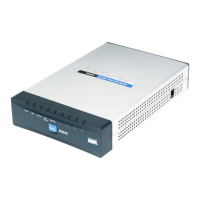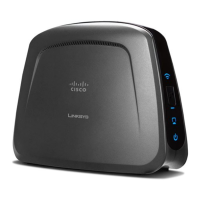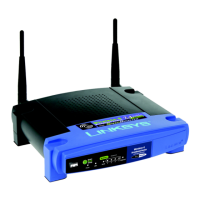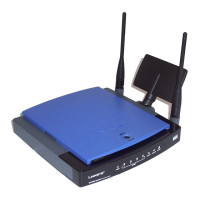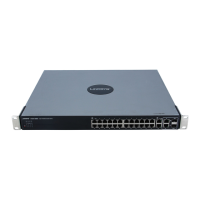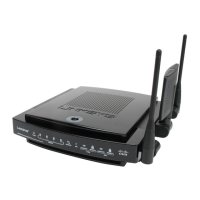Do you have a question about the Cisco Linksys EtherFast BEFVP41 and is the answer not in the manual?
Explains icons used in the guide for clarity.
Lists helpful websites for support, glossary, and security.
Provides information on intellectual property and copyright.
Defines what a VPN is and its basic principles.
Illustrates typical VPN tunnel scenarios for routers and clients.
Describes the indicators and controls on the router's front panel.
Details the ports and reset button on the router's rear.
Instructions for accessing the router's configuration interface.
Configuration for initial network settings, including connection type.
Section for configuring the router's connection to the Internet.
Settings for configuring a static IP address for Internet connection.
Configuration for Point-to-Point Protocol over Ethernet connections.
Settings for Remote Access Service, specific to Singapore users.
Configuration for Point-to-Point Tunneling Protocol connections.
Setup for Heart Beat Signal connections, specific to Australia.
Network configuration options like Host Name, Domain Name, and MTU.
Configures network settings for Ethernet ports and DHCP.
Manages the router's DHCP server for automatic IP assignment.
Configuration for Dynamic Domain Name System for dynamic IP addresses.
Allows cloning the MAC address for ISP registration.
Configures dynamic and static routing for network traffic.
Sets up pre-determined pathways for network information.
Configures the firewall to filter unwanted traffic.
Settings for configuring Virtual Private Network tunnels.
Allows IPSec and PPTP tunnels to pass through the router.
Creates secure connections between two endpoints for data transmission.
Defines which devices can access the VPN tunnel.
Specifies the VPN device at the other end of the tunnel.
Configures encryption, authentication, and key exchange for VPN tunnels.
Manual setup for encryption and authentication keys.
Displays the current status of the VPN tunnel.
Detailed configuration for VPN tunnel phases, proposals, and security.
Establishes the initial security association (SA) for VPN tunnels.
Creates IPSec SAs for keying VPN sessions.
Allows blocking or allowing Internet usage based on policies.
Sets up public services on the network by forwarding ports.
Watches outgoing data for specific ports and remembers IP addresses.
Configures UPnP settings for automatic port forwarding.
Exposes a network computer to the Internet for specific services.
Manages router functions for access and security, including passwords.
Sets or changes the router's web-based utility password.
Manages logging of Internet connection traffic and email alerts.
Configuration for Simple Network Management Protocol for network monitoring.
Tools for checking network device connections, including Ping Test.
Restores the router's configuration to its original factory settings.
Settings for performing diagnostic ping tests to check connectivity.
Process for updating the router's firmware.
Displays hardware and software versions, MAC address, and current time.
Shows information about the local wired network and DHCP clients.
Displays local interface details like MAC address, IP, and subnet mask.
Status of the router's DHCP server function.
Lists devices assigned IP addresses by the DHCP server.
Step-by-step instructions to resolve internet connectivity issues for computers.
Explains requirement for a cable/DSL modem for high-speed connection.
General guidance on accessing and changing router settings.
Introduces the appendix on setting up VPN tunnels between routers.
Step-by-step guide for configuring a VPN tunnel through the router interface.
Identifies the specific router model.
Lists the networking standards supported by the router.
Lists the types and number of RJ-45 ports available.
Provides details on operating conditions and physical specifications.
Outlines the terms and duration of the product's limited warranty.
Lists conditions under which the warranty is not applicable.
Instructions on how to get support and claim warranty service.
Compliance statement regarding FCC rules for digital devices.
Important safety precautions for using the equipment.
Statement of compliance with European directives.
Information on proper disposal and recycling of electronic equipment.
Environmental disposal guidelines for EU customers in English.
Environmental disposal guidelines for EU customers in Spanish.
Environmental disposal guidelines for EU customers in French.
Environmental disposal guidelines for EU customers in Italian.
Environmental disposal guidelines for EU customers in Dutch.
Environmental disposal guidelines for EU customers in Norwegian.
Environmental disposal guidelines for EU customers in Polish.
Describes software included in Linksys products, including open source.
Details where to find applicable software licenses and terms.
Full license agreement for software provided by Linksys.
Grants a non-exclusive license to use the software embedded in the product.
Covers trade secrets, copyrighted materials, and restrictions on use.
Explains how Linksys may collect and process user information.
Terms and conditions for the GNU General Public License.
Defines rules for copying, distributing, and modifying GPL-licensed software.
Option to apply GPL instead of LGPL, with specific notice requirements.
Specifies requirements for distributing Library code in object or executable form.
Defines "work that uses the Library" and its scope under the license.
Exception allowing combination/linking of works with the Library under specific terms.
Rules for distributing combined libraries containing LGPL-covered parts.
Prohibits actions not expressly permitted by the license.
Explains acceptance by modifying or distributing the Library.
Recipient receives license automatically upon redistribution.
Addresses patent infringement and conflicting obligations.
License terms for GNU Lesser General Public License (LGPL) Version 2.1.
Specifies the terms for the Lesser General Public License.
Version number and release date of the LGPL.
Explains the purpose of GNU licenses in guaranteeing user freedom.
Defines LGPL applicability and terms for licensees.
Conditions for copying and distributing verbatim LGPL source code.
Details terms for modifying and distributing LGPL-licensed works.
Option to apply GPL instead of LGPL, with specific notice requirements.
Specifies requirements for distributing Library code in object or executable form.
Defines "work that uses the Library" and its scope under the license.
Exception allowing combination/linking of works with the Library under specific terms.
Rules for distributing combined libraries containing LGPL-covered parts.
Prohibits actions not expressly permitted by the LGPL license.
Explains acceptance by modifying or distributing the Library.
Recipient receives LGPL license automatically upon redistribution.
Addresses patent infringement and conflicting obligations for LGPL.
Handles geographical distribution limitations for Library use.
Explains how FSF publishes new versions of the LGPL.
Procedure for incorporating Library parts into other programs with different licenses.
States that the Library is provided without warranty.
License terms for OpenSSL software included in the product.
License terms for the OpenSSL Project software.
License terms for the original SSLeay SSL implementation.
Explains icons used in the guide for clarity.
Lists helpful websites for support, glossary, and security.
Provides information on intellectual property and copyright.
Defines what a VPN is and its basic principles.
Illustrates typical VPN tunnel scenarios for routers and clients.
Describes the indicators and controls on the router's front panel.
Details the ports and reset button on the router's rear.
Instructions for accessing the router's configuration interface.
Configuration for initial network settings, including connection type.
Section for configuring the router's connection to the Internet.
Settings for configuring a static IP address for Internet connection.
Configuration for Point-to-Point Protocol over Ethernet connections.
Settings for Remote Access Service, specific to Singapore users.
Configuration for Point-to-Point Tunneling Protocol connections.
Setup for Heart Beat Signal connections, specific to Australia.
Network configuration options like Host Name, Domain Name, and MTU.
Configures network settings for Ethernet ports and DHCP.
Manages the router's DHCP server for automatic IP assignment.
Configuration for Dynamic Domain Name System for dynamic IP addresses.
Allows cloning the MAC address for ISP registration.
Configures dynamic and static routing for network traffic.
Sets up pre-determined pathways for network information.
Configures the firewall to filter unwanted traffic.
Settings for configuring Virtual Private Network tunnels.
Allows IPSec and PPTP tunnels to pass through the router.
Creates secure connections between two endpoints for data transmission.
Defines which devices can access the VPN tunnel.
Specifies the VPN device at the other end of the tunnel.
Configures encryption, authentication, and key exchange for VPN tunnels.
Manual setup for encryption and authentication keys.
Displays the current status of the VPN tunnel.
Detailed configuration for VPN tunnel phases, proposals, and security.
Establishes the initial security association (SA) for VPN tunnels.
Creates IPSec SAs for keying VPN sessions.
Allows blocking or allowing Internet usage based on policies.
Sets up public services on the network by forwarding ports.
Watches outgoing data for specific ports and remembers IP addresses.
Configures UPnP settings for automatic port forwarding.
Exposes a network computer to the Internet for specific services.
Manages router functions for access and security, including passwords.
Sets or changes the router's web-based utility password.
Manages logging of Internet connection traffic and email alerts.
Configuration for Simple Network Management Protocol for network monitoring.
Tools for checking network device connections, including Ping Test.
Restores the router's configuration to its original factory settings.
Settings for performing diagnostic ping tests to check connectivity.
Process for updating the router's firmware.
Displays hardware and software versions, MAC address, and current time.
Shows information about the local wired network and DHCP clients.
Displays local interface details like MAC address, IP, and subnet mask.
Status of the router's DHCP server function.
Lists devices assigned IP addresses by the DHCP server.
Step-by-step instructions to resolve internet connectivity issues for computers.
Explains requirement for a cable/DSL modem for high-speed connection.
General guidance on accessing and changing router settings.
Introduces the appendix on setting up VPN tunnels between routers.
Step-by-step guide for configuring a VPN tunnel through the router interface.
Identifies the specific router model.
Lists the networking standards supported by the router.
Lists the types and number of RJ-45 ports available.
Provides details on operating conditions and physical specifications.
Outlines the terms and duration of the product's limited warranty.
Lists conditions under which the warranty is not applicable.
Instructions on how to get support and claim warranty service.
Compliance statement regarding FCC rules for digital devices.
Important safety precautions for using the equipment.
Statement of compliance with European directives.
Information on proper disposal and recycling of electronic equipment.
Environmental disposal guidelines for EU customers in English.
Environmental disposal guidelines for EU customers in Spanish.
Environmental disposal guidelines for EU customers in French.
Environmental disposal guidelines for EU customers in Italian.
Environmental disposal guidelines for EU customers in Dutch.
Environmental disposal guidelines for EU customers in Norwegian.
Environmental disposal guidelines for EU customers in Polish.
Describes software included in Linksys products, including open source.
Details where to find applicable software licenses and terms.
Full license agreement for software provided by Linksys.
Grants a non-exclusive license to use the software embedded in the product.
Covers trade secrets, copyrighted materials, and restrictions on use.
Explains how Linksys may collect and process user information.
Terms and conditions for the GNU General Public License.
Defines rules for copying, distributing, and modifying GPL-licensed software.
Option to apply GPL instead of LGPL, with specific notice requirements.
Specifies requirements for distributing Library code in object or executable form.
Defines "work that uses the Library" and its scope under the license.
Exception allowing combination/linking of works with the Library under specific terms.
Rules for distributing combined libraries containing LGPL-covered parts.
Prohibits actions not expressly permitted by the license.
Explains acceptance by modifying or distributing the Library.
Recipient receives license automatically upon redistribution.
Addresses patent infringement and conflicting obligations.
License terms for GNU Lesser General Public License (LGPL) Version 2.1.
Specifies the terms for the Lesser General Public License.
Version number and release date of the LGPL.
Explains the purpose of GNU licenses in guaranteeing user freedom.
Defines LGPL applicability and terms for licensees.
Conditions for copying and distributing verbatim LGPL source code.
Details terms for modifying and distributing LGPL-licensed works.
Option to apply GPL instead of LGPL, with specific notice requirements.
Specifies requirements for distributing Library code in object or executable form.
Defines "work that uses the Library" and its scope under the license.
Exception allowing combination/linking of works with the Library under specific terms.
Rules for distributing combined libraries containing LGPL-covered parts.
Prohibits actions not expressly permitted by the LGPL license.
Explains acceptance by modifying or distributing the Library.
Recipient receives LGPL license automatically upon redistribution.
Addresses patent infringement and conflicting obligations for LGPL.
Handles geographical distribution limitations for Library use.
Explains how FSF publishes new versions of the LGPL.
Procedure for incorporating Library parts into other programs with different licenses.
States that the Library is provided without warranty.
License terms for OpenSSL software included in the product.
License terms for the OpenSSL Project software.
License terms for the original SSLeay SSL implementation.
| Brand | Cisco |
|---|---|
| Model | Linksys EtherFast BEFVP41 |
| Category | Network Router |
| Language | English |


